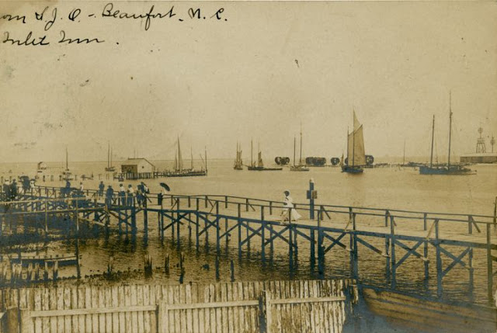
Tourism in Beaufort
Tourism and recreation have long been a part of Beaufort’s history, and predate the Beaufort Now consumptive era. Due to the town’s importance as a trade center, small hotels and boarding houses were built to accommodate fishers and seafaring travelers (11, 21). The accommodation industry originally existed in part to support commercial fishing activities, but as more and more travelers became aware of the town’s existence visitors arrived not only for economic opportunities but also to explore Beaufort’s beautiful coastlines (17). As early as the 1850s, Beaufort began to invest in the resort business. Many of the boarding houses began catering to seasonal guests, and larger hotels were built along the waterfront. For example, The Atlantic Hotel became a popular summertime destination for the social and political elite from central and western North Carolina (17). Patrons enjoyed fine dining and outings to Cape Lookout to spend a day in the sun, looking for ocean treasures, and exploring sand dunes around the lighthouse (11). As the resort business gained greater economic importance and statewide transportation networks became better connected, the isolated coast began to attract visitors from Massachusetts to Florida, and even international guests (17).
Beginning in the 1930s, investments in water-based recreational activities expanded, with fishing piers being built along the waterfront and regional hotels beginning to cater to recreational fishers (17, 22). By the 1950s, group tour boating and chartered recreational fishing trips gained in popularity (16). Shortly after, the town recognized that its “past would make a good foundation for its future,” and began protecting Beaufort’s highly valued cultural and aesthetic amenities (11). In 1965, the town established the Historic District, which aims to preserve and protect the colonial charm of historic homes (22). Just a few years later, the town commissioned the Waterfront Revitalization Project, which further enabled Beaufort to rebrand itself a popular tourist destination (23). The desire to remove productivist activities from the waterfront continued in future development projects, reducing the amount of commercial fishing infrastructure and access points in the downtown area. By 1987, Carteret County was leading the state in tourism revenues, much of it coming from seasonal visitors and recreational fishing (16). Beaufort continues to increase in popularity as a summertime vacation destination and retirement community.
Today, downtown Beaufort is designed to support the thousands of visitors that come to explore the barrier islands, tour Beaufort’s cultural heritage sites, and participate in annual recreational fishing tournaments. Beaufort is now thriving as a consumptive-economy with the majority of businesses designed to support the tourism and recreation industry. Visitors and seasonal residents still enjoy boating trips out to Cape Lookout to view the lighthouse, and overnight stays in the various hotels and inns that dot Beaufort’s waterfront. The importance of tourism and recreation reflects and contributes to a community and regional identity tied to the joys of coastal living.

Some Key Events
For a more complete timeline of tourism in Beaufort, click here.






